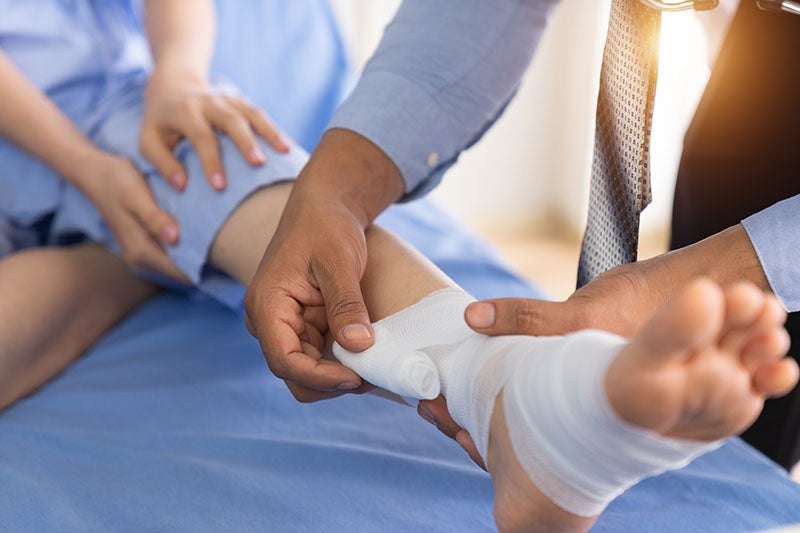What You Need to Know About Chronic Wounds
July 15, 2024
Millions of Americans are suffering with a serious chronic wound. It is an over-looked health risk that impacts upwards of eight million people in the U.S. Chronic wound sufferers can experience constant pain impacting their quality of life. Everyday activities such as working, walking, and standing are difficult. Chronic wounds can limit mobility and social activity, and because the pain is most common at night this condition sometimes causes sleep deprivation. All these factors can lead to depression and anxiety, impacting the healing process.
What is a Chronic Wound?
A chronic wound is a wound that does not heal or heals slowly; wounds that do not heal within three months are considered chronic wounds. Chronic wounds often stay in the inflammatory stage for too long and may never heal or may take years to heal.
What Causes Chronic Wounds?
All wounds have the potential to become chronic. There are several causes for chronic wounds including:
- Diabetes
- Poor Circulation
- Limited Mobility
- Repeated Trauma to a Wound Site
- Infection-Causing Bacteria
- Swelling
Types of Chronic Wounds:
Chronic Wounds are classified into four categories: each with its own typical location, depth, and appearance. A physical exam can usually diagnose a chronic wound.
Arterial – Occur when the affected area does not receive blood supply. As an area is deprived of adequate blood flow, the skin and underlying tissues begin to die, leading to an open wound. They are most often found on the toes, feet, heels or ankles.
Diabetic – Diabetes causes the arteries to stiffen and the blood vessels to narrow. This can create poor circulation and limit the ability of red and white blood cells to travel to wound sites. Diabetes may also lead to nerve damage, especially in the legs, ankles and feet resulting in a lack of sensation which increases a person’s risk of sustaining wounds in the lower extremities.
Pressure – Patients most at risk for pressure ulcers include people with limited mobility due to illness, injury or paralysis. Other risk factors include people living with obesity, poor nutrition and urinary and/or bowel incontinence. Pressure ulcers occur in areas with bony prominences, such as the heels, ankles, coccyx and hips.
Venous ulcer – Occur when blood pools up in the veins due to valves that are not working properly to push the blood back up to the heart. They are most often found just above the ankle.
What are symptoms of non-healing wounds?
Frequently, wounds are a secondary complication for people with more complex medical conditions. Although symptoms can vary from person to person, the most common symptoms include:
- Persistent and increased tenderness or pain in the area
- Increased swelling, inflammation, redness or blistering
- changes in skin color, darkened skin around the wound
- Fever, itching
- Increased drainage from the wound with or without a noticeable odor
Treatments & Interventions:
The longer a wound goes untreated the greater the risk of infection, hospitalization, or amputation. Chronic wounds require specialized care and treatment. Advanced wound care experts have a host of modalities in which to treat chronic wounds.
Debridement: the removal of dead or infected tissue. Tissue is removed using medical instruments or high-pressure water jet. Because debridement can be painful, a local anesthetic is often used to numb the wound beforehand.
Hyperbaric oxygen therapy: surrounds the patient with 100 percent oxygen to help accelerate wound healing. Patients will spend a determined amount of time in a special chamber to increase the oxygen concentration in the blood to improve the blood supply to the wound area.
Negative pressure wound therapy: the wound is covered with an airtight dressing that is connected to a pump by a thin tube. The pump sucks fluid out of the wound, creating negative pressure across the surface of the wound with the aim of increasing the flow blood to the wound.
Wound dressings: the dressings are used to remove excess fluid from the wound and protect it from infection. Substances called growth factors can be put on the wound to help the cells grow. Growth factors can include platelet rich plasma, or they can also be made chemically.
Total contact casting: this is a specific casting technique used to heal diabetic foot ulcers by distributing weight along the entire sole of the foot. The total contact cast relieves the pressure on the prominent areas of the foot, which allows ulcers to heal.
Skin grafts: grafts are an option if the wound is so large that it is unable to close on its own. In this procedure, skin is taken from another part of the body and transplanted to the wound. Grafts made from human cell products and synthetic material may also be considered.

More About Our Wound Centers
Trinity Health Of New England Wound Healing Centers offer effective outpatient wound treatment including most or all these treatment options. Our team of doctors, nurses and therapists provide specialized treatment to best heal their specific patient’s chronic wound. Anyone with severe bruising or skin tears who have concerns about their healing process is encouraged book an appointment at any of our locations for an evaluation.
Several of our Wound Healing Centers have consistently maintained Center of Distinction Honors from Healogics. They have achieved outstanding clinical outcomes including patient satisfaction rates higher than 92 percent and a minimum wound healing rate of at least 92 percent.
Learn More